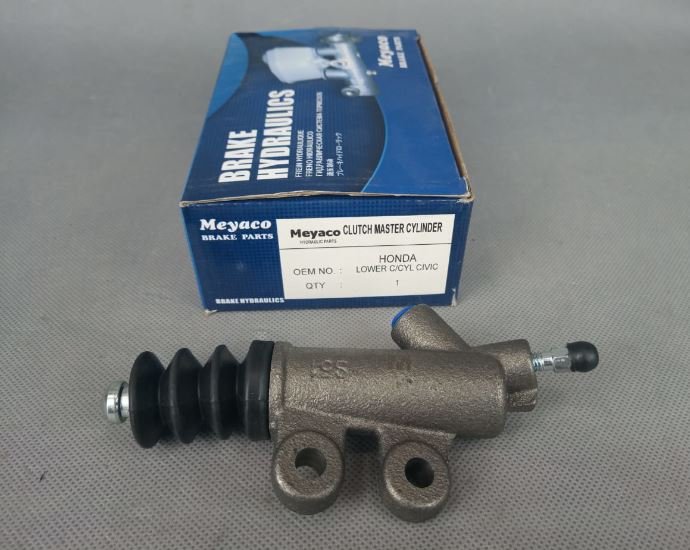Slave Cylinder: Prolonging Life and Ensuring Performance
At the heart of a vehicle’s clutch system lies a crucial component: the slave cylinder. Its primary function is to apply the necessary force to disengage the clutch when you press the pedal. This action allows the smooth transition between gears by controlling the clutch pressure plate’s engagement and disengagement. In hydraulic clutch systems, the cylinder operates through fluid dynamics, receiving pressure from the master cylinder and translating it into mechanical movement.

Slave Cylinder Maintenance: Ensuring Smooth Gear Shifts
Consistent performance and longevity of your clutch system hinge on regular maintenance of this component. It involves checking the fluid levels, inspecting for leaks, and ensuring that the connections are secure and not corroded. Regular maintenance not only guarantees smooth gear shifts but also prevents abrupt failures that could lead to more significant issues.
The Essential Guide to Replacing a Faulty Slave Cylinder
Should you encounter a malfunction, replacing the component becomes imperative. The process begins with selecting the correct replacement that matches your vehicle’s specifications. Once acquired, the system must be flushed of old fluid to prevent contamination. After installation, a thorough bleeding of the system is required to remove air pockets that could impede the hydraulic pressure.
How to Diagnose Common Slave Cylinder Issues in Cars
Diagnosing problems with this component starts with a few tell-tale signs: difficulty in shifting gears, a spongy or unresponsive clutch pedal, and visible leaks beneath the vehicle. Listening for unusual noises when the clutch pedal is engaged can also point to potential issues. A comprehensive check often involves inspecting the cylinder bore for wear and ensuring the integrity of the seals.
Hydraulic Slave Cylinders: The Heartbeat of Your Clutch
In hydraulic systems, the slave cylinder is synonymous with the heartbeat, providing the rhythmic push and pull essential for engaging and disengaging the clutch. It must respond instantly to the driver’s input, a delay or hesitation can indicate an underlying problem that needs immediate attention. This responsiveness is key to the seamless operation of the entire transmission system.
Bleeding the Slave Cylinder: A Step-by-Step Tutorial
Bleeding this component is a critical step in ensuring its optimal function. Begin by locating the bleeder valve on the cylinder. With the help of an assistant, have them depress the clutch pedal while you open the valve to release fluid and trapped air. Close the valve before the pedal is released. Repeat this process until you observe a steady stream of fluid without air bubbles. Finally, top up the reservoir with fresh fluid to the recommended level.
Master Cylinder vs. Slave Cylinder: Key Differences Explained
When delving into the hydraulic systems of a vehicle, particularly those concerning the clutch or brakes, it’s crucial to understand the roles played by the master and slave cylinders. These components are pivotal in translating your pedal pressure into the mechanical action that either changes gears or slows the car down.
The master cylinder is typically found at the driver’s pedal side. It’s the starting point of pressure in the hydraulic system. When you press the pedal, the master cylinder pressurizes brake fluid in the lines leading to the slave cylinders at each wheel or, in the case of the clutch system, to the clutch mechanism.
Conversely, the slave cylinder is the endpoint in this hydraulic relay. Located at the receiving end of this pressure, it activates the mechanism that actually engages the clutch or the vehicle’s brakes. The primary difference lies in their roles: the master cylinder initiates the pressure, while the slave cylinder performs the action demanded by the driver.
The Impact of Slave Cylinder Failure on Vehicle Performance
A malfunctioning slave cylinder can have a dramatic effect on your vehicle’s performance. If this component fails, it may lead to a clutch that doesn’t disengage properly. This can cause grinding gears during shifts, a clutch pedal that feels spongy or stays on the floor, and in extreme cases, the inability to change gears at all. In braking systems, a failing slave cylinder can result in reduced braking power or unresponsive brakes, both of which pose serious safety risks.
Top Signs That Your Slave Cylinder Needs Attention
Pay attention to the warning signs that suggest your slave cylinder is in distress. These include a soft or sinking clutch pedal, noticeable fluid leaks under the car, unusual noises when pressing the clutch pedal, and difficulty shifting gears. If you observe any of these symptoms, it’s time to inspect your slave cylinder.
Choosing the Right Slave Cylinder for Your Vehicle
Selecting an appropriate slave cylinder involves understanding your vehicle’s specifications. Always refer to your vehicle’s manual and consult with a trusted parts supplier. Ensure the new cylinder is compatible with your car’s make, model, and year. It’s also wise to consider the brand reputation and warranty offered on the parts you’re buying.
Slave Cylinder Repair Costs: What to Expect
Repair costs for a slave cylinder can vary widely based on your vehicle type and the extent of the damage. On average, you can expect parts to cost anywhere from $50 to $200, with labor adding $100 to $300 to the bill. It’s a good idea to get several quotes from different mechanics to find the most cost-effective solution.
Installing a New Slave Cylinder: Tools and Techniques
Installation of a new slave cylinder requires precision and the right tools. You’ll need a set of wrenches, a jack and jack stands, and new brake fluid. Begin by ensuring the vehicle is securely lifted. Remove the faulty cylinder, being careful to not spill brake fluid on the car’s paint, as it can cause damage. Install the new cylinder, reconnect the hydraulic line, and then bleed the system to remove air pockets. It’s a detailed process that requires patience and careful attention to detail.
Slave Cylinders and Fluid Dynamics in Automotive Engineering
The slave cylinder plays an integral role in the smooth operation of a vehicle’s clutch system. It’s a component that translates fluid dynamics into mechanical force. When you depress the clutch pedal, hydraulic pressure builds within the master cylinder and then transfers to the slave unit. This pressure moves the piston in the slave cylinder, which, in turn, disengages the clutch and allows for seamless gear transitions. This process hinges on principles of fluid dynamics, where the incompressibility of the hydraulic fluid ensures a consistent and reliable transfer of energy from pedal to clutch.
Preventive Measures to Prolong Slave Cylinder Life
To extend the life of this crucial component, routine maintenance is key. Regularly checking the hydraulic fluid level and ensuring it’s free from contamination can prevent many common issues. It’s also vital to inspect the cylinder for leaks and wear, as even minor seepage can lead to air entering the system, diminishing its efficiency. Replacing the fluid according to the manufacturer’s schedule will help maintain the proper hydraulic pressure and responsiveness of your clutch system.
The Evolution of Slave Cylinders in Modern Automobiles
Over the years, the design and functionality of slave cylinders have significantly evolved. Initially, they were simple mechanical devices, but modern versions are more complex and often integrated with electronic systems for enhanced precision. Innovations in materials and engineering have also led to more durable and longer-lasting slave cylinders that are better suited to the demanding environments within today’s vehicles.
Troubleshooting Hydraulic Clutch Problems: Slave Cylinder Focus
When facing clutch-related issues, the slave cylinder is a good starting point for diagnosis. A soft clutch pedal or difficulty in gear shifting often indicates a problem. Inspecting for fluid leaks around the cylinder and checking for damage to the connecting hose can uncover issues. If the pedal feels spongy, it may suggest air has entered the system, requiring bleeding to restore proper function.
Enhancing Your Driving Experience with a Reliable Slave Cylinder
A well-functioning slave cylinder is essential for a smooth driving experience. It allows for precise control over the clutch, ensuring that gear changes are quick and effortless. Drivers can enhance their ride by opting for high-quality replacement parts and adhering to maintenance schedules, which contribute to the longevity and reliability of the clutch system.
Comparative Analysis of OEM vs. Aftermarket Slave Cylinders
When it comes to replacement, you have two main options: OEM (Original Equipment Manufacturer) or aftermarket parts. OEM cylinders are designed specifically for your vehicle and guarantee a perfect fit and optimal performance. Aftermarket options, however, can offer a more cost-effective solution and sometimes improved performance or durability over OEM parts. It’s crucial to weigh factors such as warranty, cost, and reviews when choosing between OEM and aftermarket slave cylinders to ensure you’re making the best decision for your vehicle.





